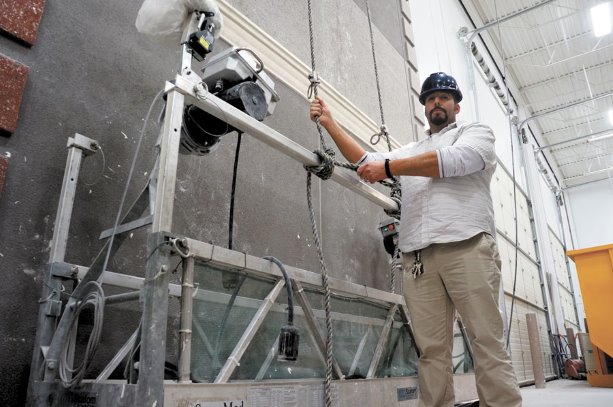Expect the Ministry of Labour (MOL) to hire a spate of inspectors this year to enforce its amended construction projects regulation governing suspended access equipment (SAE).
The amendment, effective Jan. 1, 2017, covers updated training requirements for workers who operate, install and inspect suspended work platform systems.
Nick Orfeo, occupational health and safety facilitator at the Interior Finishing Systems Training Centre (IFSTC), says that in each of the last three years the MOL has hired roughly 40 inspectors to manage safety on construction projects in Ontario, so it should come as no surprise that they will follow this year with more.
In response to the new regulations, the IFSTC and other training organizations such as the Infrastructure Health and Safety Association (IHSA) are ramping up training with revisions to their courses in SAE.
The IFSTC trains unionized members of the Carpenters Local 675 and the International Union of Painters and Allied Trades (IUPAT).
Orfeo says the regulations will require "a substantial increase" in equipment testing by the equipment owners — often rental companies used by the contractor.
"There are also changes to definitions such as substituting the words suspended scaffold for suspended work platform." Orfeo says.
He adds revisions to terms such as "critical weld" are on the books now. The new definition states that such a weld may cause in part or whole the failure of the SAE system. "The old regulations regarding SAE were less specific."
The regulations, furthermore, require contractors to have a detailed plan for how swing stages are set up on their project.
All parts used in assembly of SAE must be from a particular swing stage model, he says. In the past when parts such as brackets went missing, workers may have substituted them with parts from different systems.
"You can’t get away with that anymore."
Orfeo doesn’t believe the regulations will hamper project flow. "On the contrary, when safety is properly implemented into the task, it only serves to increase efficiency."
He sees the new regulations as part of "an ongoing process of gradual change toward the improvement of OH&S (occupational health and safety), which has been going on for decades."
As an example, when he first got into the industry about 30 years ago, SAE only had a toe plate on the front section of the platform (swing stage). Guardrails did not become standard practice until later in his career.
Orfeo says to qualify for the two-day SAE course at the IFSTC, students must first complete a number of courses, including Working at Heights (WAH).
WAH covers site-specific rescue plans which prepare workers for any case scenario, such as what to do when a worker is suspended in a safety harness as a result of a fall.
Venous pooling and suspension trauma are terms for injuries resulting when workers are suspended for extended periods in safety harnesses, says Orfeo, noting that workers can begin feeling the effects of "orthostatic intolerance" within minutes (depending on their physical condition) resulting in blood pooling in lower limbs and being cut off from circulating to the brain.
The scenario can be severe and fatal if the worker is not rescued quickly, he points out.
"Safety harnesses equipped with suspension trauma relief straps give suspended workers more time by allowing them to adjust their weight distribution within the harness thus releasing pressure on their arteries," explains Bruno Venturo, IFSTC instructor.
But harnesses so equipped are typically only used in isolated locations where emergency assistance is some distance away, Venturo adds.
Among the industry’s workers particularly susceptible to SAE accidents are glaziers, EIFS/stucco, metal cladding applicators, exterior drywall and heavy gauge stud workers.
However, it is not only workers at heights who are at risk. Falling tools, materials and parts of SAE equipment can put the workers below and the public in danger, says Orfeo, adding equipment and buildings can be damaged by falling debris.
Both IFSTC instructors suggest that while accident rates vary from year to year, increasing rates (typically during busy times) may in part be linked to aging equipment, not just worker error.




Recent Comments
comments for this post are closed